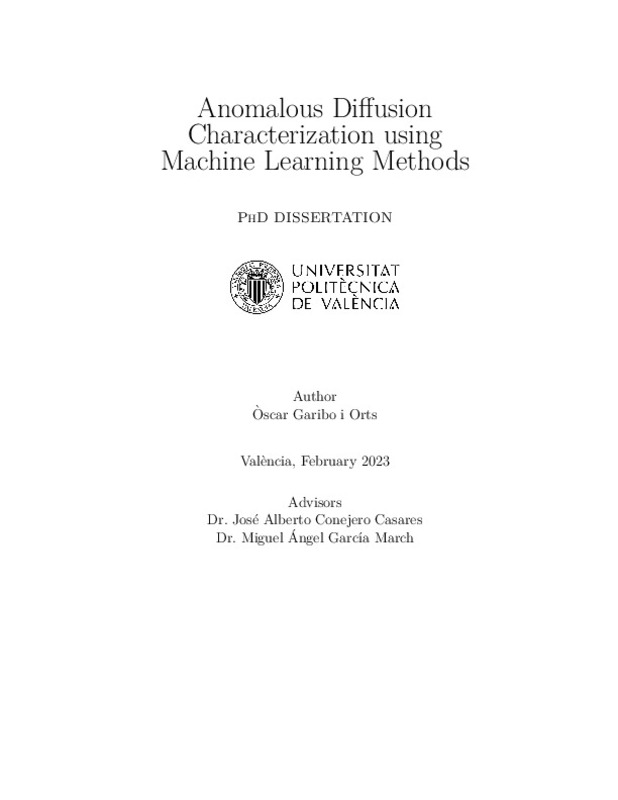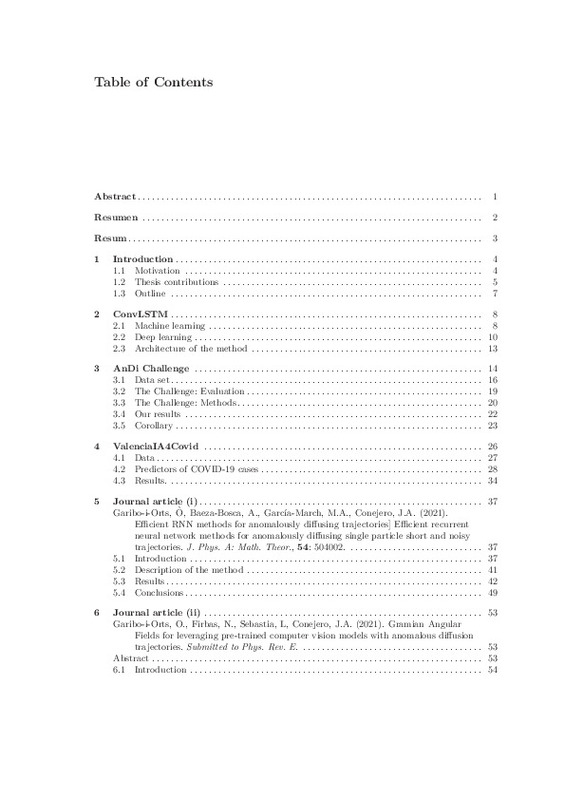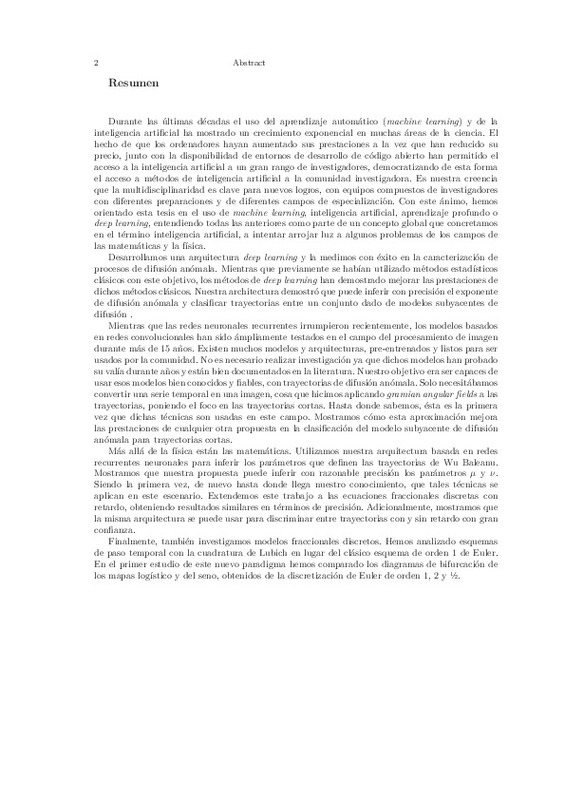- RiuNet repositorio UPV
- :
- Investigación
- :
- Tesis doctorales
- :
- Ver ítem
JavaScript is disabled for your browser. Some features of this site may not work without it.
Buscar en RiuNet
Listar
Mi cuenta
Estadísticas
Ayuda RiuNet
Admin. UPV
Anomalous Diffusion Characterization using Machine Learning Methods
Mostrar el registro sencillo del ítem
Ficheros en el ítem
| dc.contributor.advisor | Conejero Casares, José Alberto
|
es_ES |
| dc.contributor.advisor | Garcia March, Miguel Angel
|
es_ES |
| dc.contributor.author | Garibo Orts, Óscar
|
es_ES |
| dc.date.accessioned | 2023-04-19T10:55:53Z | |
| dc.date.available | 2023-04-19T10:55:53Z | |
| dc.date.created | 2023-03-06 | |
| dc.date.issued | 2023-04-18 | es_ES |
| dc.identifier.uri | http://hdl.handle.net/10251/192831 | |
| dc.description | Tesis por compendio | es_ES |
| dc.description.abstract | [ES] Durante las últimas décadas el uso del aprendizaje automático (machine learning) y de la inteligencia artificial ha mostrado un crecimiento exponencial en muchas áreas de la ciencia. El hecho de que los ordenadores hayan aumentado sus restaciones a la vez que han reducido su precio, junto con la disponibilidad de entornos de desarrollo de código abierto han permitido el acceso a la inteligencia artificial a un gran rango de investigadores, democratizando de esta forma el acceso a métodos de inteligencia artificial a la comunidad investigadora. Es nuestra creencia que la multidisciplinaridad es clave para nuevos logros, con equipos compuestos de investigadores con diferentes preparaciones y de diferentes campos de especialización. Con este ánimo, hemos orientado esta tesis en el uso de machine learning inteligencia artificial, aprendizaje profundo o deep learning, entendiendo todas las anteriores como parte de un concepto global que concretamos en el término inteligencia artificial, a intentar arrojar luz a algunos problemas de los campos de las matemáticas y la física. Desarrollamos una arquitectura deep learning y la medimos con éxito en la caracterización de procesos de difusión anómala. Mientras que previamente se habían utilizado métodos estadísticos clásicos con este objetivo, los métodos de deep learning han demostrado mejorar las prestaciones de dichos métodos clásicos. Nuestra architectura demostró que puede inferir con precisión el exponente de difusión anómala y clasificar trayectorias entre un conjunto dado de modelos subyacentes de difusión . Mientras que las redes neuronales recurrentes irrumpieron recientemente, los modelos basados en redes convolucionales han sido ámpliamente testados en el campo del procesamiento de imagen durante más de 15 años. Existen muchos modelos y arquitecturas, pre-entrenados y listos para ser usados por la comunidad. No es necesario realizar investigación ya que dichos modelos han probado su valía durante años y están bien documentados en la literatura. Nuestro objetivo era ser capaces de usar esos modelos bien conocidos y fiables, con trayectorias de difusión anómala. Solo necesitábamos convertir una serie temporal en una imagen, cosa que hicimos aplicando gramian angular fields a las trayectorias, poniendo el foco en las trayectorias cortas. Hasta donde sabemos, ésta es la primera vez que dichas técnicas son usadas en este campo. Mostramos cómo esta aproximación mejora las prestaciones de cualquier otra propuesta en la clasificación del modelo subyacente de difusión anómala para trayectorias cortas. Más allá de la física están las matemáticas. Utilizamos nuestra arquitectura basada en redes recurrentes neuronales para inferir los parámetros que definen las trayectorias de Wu Baleanu. Mostramos que nuestra propuesta puede inferir con azonable precisión los parámetros mu y nu. Siendo la primera vez, de nuevo hasta donde llega nuestro conocimiento, que tales técnicas se aplican en este escenario. Extendemos este trabajo a las ecuaciones fraccionales discretas con retardo, obteniendo resultados similares en términos de precisión. Adicionalmente, mostramos que la misma arquitectura se puede usar para discriminar entre trayectorias con y sin retardo con gran confianza. Finalmente, también investigamos modelos fraccionales discretos. Hemos analizado esquemas de paso temporal con la cuadratura de Lubich en lugar del clásico esquema de orden 1 de Euler. En el primer estudio de este nuevo paradigma hemos comparado los diagramas de bifurcación de los mapas logístico y del seno, obtenidos de la discretización de Euler de orden 1, 2 y 1/2. | es_ES |
| dc.description.abstract | [CAT] Durant les darreres dècades l'ús de l'aprenentatge automàtic (machine learning) i de la intel.ligència artificial ha mostrat un creixement exponencial en moltes àrees de la ciència. El fet que els ordinadors hagen augmentat les seues prestacions a la vegada que han reduït el seu preu, junt amb la disponibilitat d'entorns de desenvolupament de codi obert han permès l'accés a la intel.ligència artificial a un gran rang d'investigadors, democratitzant així l'accés a mètodes d'intel.ligència artificial a la comunitat investigadora. És la nostra creença que la multidisciplinaritat és clau per a nous èxits, amb equips compostos d'investigadors amb diferents preparacions i diferents camps d'especialització. Amb aquest ànim, hem orientat aquesta tesi en l'ús d'intel.ligència artificial machine learning, aprenentatge profund o deep learning, entenent totes les anteriors com a part d'un concepte global que concretem en el terme intel.ligència, a intentar donar llum a alguns problemes dels camps de les matemàtiques i la física. Desenvolupem una arquitectura deep learning i la mesurem amb èxit en la caracterització de processos de difusió anòmala. Mentre que prèviament s'havien utilitzat mètodes estadístics clàssics amb aquest objectiu, els mètodes de deep learning han demostrat millorar les prestacions d'aquests mètodes clàssics. La nostra architectura va demostrar que pot inferir amb precisió l'exponent de difusió anòmala i classificar trajectòries entre un conjunt donat de models subjacents de difusió. Mentre que les xarxes neuronals recurrents van irrompre recentment, els models basats en xarxes convolucionals han estat àmpliament testats al camp del processament d'imatge durant més de 15 anys. Hi ha molts models i arquitectures, pre-entrenats i llestos per ser usats per la comunitat. No cal fer recerca ja que aquests models han provat la seva vàlua durant anys i estan ben documentats a la literatura. El nostre objectiu era ser capaços de fer servir aquests models ben coneguts i fiables, amb trajectòries de difusió anòmala. Només necessitàvem convertir una sèrie temporal en una imatge, cosa que vam fer aplicant gramian angular fields a les trajectòries, posant el focus a les trajectòries curtes. Fins on sabem, aquesta és la primera vegada que aquestes tècniques són usades en aquest camp. Mostrem com aquesta aproximació millora les prestacions de qualsevol altra proposta a la classificació del model subjacent de difusió anòmala per a trajectòries curtes. Més enllà de la física hi ha les matemàtiques. Utilitzem la nostra arquitectura basada en xarxes recurrents neuronals per inferir els paràmetres que defineixen les trajectòries de Wu Baleanu. Mostrem que la nostra proposta pot inferir amb raonable precisió els paràmetres mu i nu. Sent la primera vegada, novament fins on arriba el nostre coneixement, que aquestes tècniques s'apliquen en aquest escenari. Estenem aquest treball a les equacions fraccionals discretes amb retard, obtenint resultats similars en termes de precisió. Addicionalment, mostrem que la mateixa arquitectura es pot fer servir per discriminar entre trajectòries amb i sense retard amb gran confiança. Finalment, també investiguem models fraccionals discrets. Hem analitzat esquemes de pas temporal amb la quadratura de Lubich en lloc del clàssic esquema d'ordre 1 d'Euler. Al primer estudi d'aquest nou paradigma hem comparat els diagrames de bifurcació dels mapes logístic i del sinus, obtinguts de la discretització d'Euler d'ordre 1, 2 i 1/2. | es_ES |
| dc.description.abstract | [EN] During the last decades the use of machine learning and artificial intelligence have showed an exponential growth in many areas of science. The fact that computer's hardware has increased its performance while lowering the price and the availability of open source frameworks have enabled the access to artificial intelligence to a broad range of researchers, hence democratizing the access to artificial intelligence methods to the research community. It is our belief that multi-disciplinarity is the key to new achievements, with teams composed of researchers with different backgrounds and fields of specialization. With this aim, we focused this thesis in using machine learning, artificial intelligence, deep learing, all of them being understood as part of a whole concept we concrete in artificial intelligence, to try to shed light to some problems from the fields of mathematics and physics. A deep learning architecture was developed and successfully benchmarked with the characterization of anomalous diffusion processes. Whereas traditional statistical methods had previously been used with this aim, deep learing methods, mainly based on recurrent neural networks have proved to outperform these clasical methods. Our architecture showed it can precisely infer the anomalous diffusion exponent and accurately classify trajectories among a given set of underlaying diffusion models. While recurrent neural networks irrupted in the recent years, convolutional network based models had been extensively tested in the field of image processing for more than 15 years. There exist many models and architectures, pre-trained and set to be used by the community. No further investigation needs to be done since the architecture have proved their value for years and are very well documented in the literature. Our goal was being able to used this well-known and reliable models with anomalous diffusion trajectories. We only needed to be able to convert a time series into an image, which we successfully did by applying gramian angular fields to the trajectories, focusing on short ones. To our knowledge this is the first time these techniques were used in this field. We show how this approach outperforms any other proposal in the underlaying diffusion model classification for short trajectories. Besides physics it is maths. We used our recurrent neural networks architecture to infer the parameters that define the Wu Baleanu trajectories. We show that our proposal can precisely infer both the mu and nu parameters with a reasonable confidence. Being the first time, to the best of our knowledge, that such techniques were applied to this scenario. We extend this work to the discrete delayed fractional equations, obtaining similar results in terms of precision. Additionally, we showed that the same architecture can be used to discriminate delayed from non-delayed trajectories with a high confidence. Finally, we also searched fractional discrete models. We have considered Lubich's quadrature time-stepping schemes instead of the classical Euler scheme of order 1. As the first study with this new paradigm, we compare the bifurcation diagrams for the logistic and sine maps obtained from Euler discretizations of orders 1, 2, and 1/2. | es_ES |
| dc.description.sponsorship | J.A.C. acknowledges support from ALBATROSS project (National Plan for Scientific and Technical Research and Innovation 2017-2020, No. PID2019-104978RB-I00). M.A.G.M. acknowledges funding from the Spanish Ministry of Education and Vocational Training (MEFP) through the Beatriz Galindo program 2018 (BEAGAL18/00203) and Spanish Ministry MINECO (FIDEUA PID2019- 106901GBI00/10.13039/501100011033). We thank M.A. Garc ́ıa-March for helpful comments and discussions on the topic. NF is sup- ported by the National University of Singapore through the Singapore International Graduate Student Award (SINGA) program. OGO and LS acknowledge funding from MINECO project, grant TIN2017-88476-C2-1-R. JAC acknowledges funding from grant PID2021-124618NB-C21 funded by MCIN/AEI/ 10.13039/501100011033 and by “ERDF A way of making Europe”, by the “European Union”. We also thank funding for the open access charges from CRUE-Universitat Politècnica de València. | es_ES |
| dc.format.extent | 107 | es_ES |
| dc.language | Inglés | es_ES |
| dc.publisher | Universitat Politècnica de València | es_ES |
| dc.rights | Reserva de todos los derechos | es_ES |
| dc.subject | Difusión anómala | es_ES |
| dc.subject | Aprendizaje automático | es_ES |
| dc.subject | Aprendizaje profundo | es_ES |
| dc.subject | Sistemas dinámicos fraccionarios | es_ES |
| dc.subject | Sistemas fraccionarios discretos retardados | es_ES |
| dc.subject | Sistemas caóticos | es_ES |
| dc.subject | Redes neuronales recurrentes | es_ES |
| dc.subject | Anomalous diffusion | es_ES |
| dc.subject | Machine learning | es_ES |
| dc.subject | Deep learning | es_ES |
| dc.subject | Fractional dynamical systems | es_ES |
| dc.subject | Delayed discrete fractional systems | es_ES |
| dc.subject | Chaotic systems | es_ES |
| dc.subject | Recurrent neural networks | es_ES |
| dc.subject.classification | MATEMATICA APLICADA | es_ES |
| dc.title | Anomalous Diffusion Characterization using Machine Learning Methods | es_ES |
| dc.type | Tesis doctoral | es_ES |
| dc.identifier.doi | 10.4995/Thesis/10251/192831 | es_ES |
| dc.relation.projectID | info:eu-repo/grantAgreement/ //BEAGAL18%2F00203//AYUDA BEATRIZ GALINDO MODALIDAD JUNIOR-GARCIA MARCH/ | es_ES |
| dc.relation.projectID | info:eu-repo/grantAgreement/AEI/Plan Estatal de Investigación Científica y Técnica y de Innovación 2013-2016/TIN2017-88476-C2-1-R/ES/RECONOCIMIENTO DE ACTIVIDADES Y PLANIFICACION AUTOMATICA PARA EL DISEÑO DE ASISTENTES INTELIGENTES/ | es_ES |
| dc.relation.projectID | info:eu-repo/grantAgreement/AEI/Plan Estatal de Investigación Científica y Técnica y de Innovación 2017-2020/PID2019-106901GB-I00/ES/PHYSICS OF NEW CHALLENGES/ | es_ES |
| dc.relation.projectID | info:eu-repo/grantAgreement/AEI/Plan Estatal de Investigación Científica y Técnica y de Innovación 2017-2020/PID2019-104978RB-I00/ES/SISTEMA DE AYUDA A LA DECISION VALIDADO CLINICAMENTE BASADO EN MODELOS DE INTELIGENCIA ARTIFICIAL A NIVEL DE PIXEL PARA DECIDIR OPCIONES TERAPEUTICAS EN GLIOBLASTOMA/ | es_ES |
| dc.rights.accessRights | Abierto | es_ES |
| dc.contributor.affiliation | Universitat Politècnica de València. Departamento de Matemática Aplicada - Departament de Matemàtica Aplicada | es_ES |
| dc.description.bibliographicCitation | Garibo Orts, Ó. (2023). Anomalous Diffusion Characterization using Machine Learning Methods [Tesis doctoral]. Universitat Politècnica de València. https://doi.org/10.4995/Thesis/10251/192831 | es_ES |
| dc.description.accrualMethod | TESIS | es_ES |
| dc.type.version | info:eu-repo/semantics/acceptedVersion | es_ES |
| dc.relation.pasarela | TESIS\14331 | es_ES |
| dc.contributor.funder | Agencia Estatal de Investigación | es_ES |
| dc.description.compendio | Compendio | es_ES |
Este ítem aparece en la(s) siguiente(s) colección(ones)
-
Tesis doctorales [5213]










